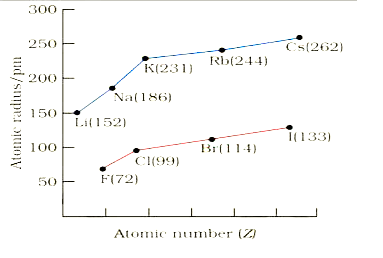Which of these properties increase across the period from N to CI?
(P) Atomic radius
(Q) Density
(R) Electronegativity
P only
R only
P and Q only
Q and R only
The correct Answer is:D
Step by step video, text & image solution for Which of these properties increase across the period from N to CI? (P) Atomic radius (Q) Density (R) Electronegativity by Chemistry experts to help you in doubts & scoring excellent marks in Class 11 exams.
Updated on:21/07/2023Topper's Solved these Questions
- PERIODIC TABLEBook:GRB PUBLICATIONChapter:PERIODIC TABLEExercise:F.Acidic-Basic Character, Hydration etc.
Explore 45 Videos
- PERIODIC TABLEBook:GRB PUBLICATIONChapter:PERIODIC TABLEExercise:Reasoning Type
Explore 29 Videos
- PERIODIC TABLEBook:GRB PUBLICATIONChapter:PERIODIC TABLEExercise:D. Electron Gain Enthalpy (Electron Affinity)
Explore 50 Videos
- NOMENCLATURE AND CLASSIFICATIONBook:GRB PUBLICATIONChapter:NOMENCLATURE AND CLASSIFICATIONExercise:Subjective Type
Explore 24 Videos
- PRACTICAL ORGANIC CHEMISTRYBook:GRB PUBLICATIONChapter:PRACTICAL ORGANIC CHEMISTRYExercise:Exercise 4 (Matrix match type )
Explore 1 Video
Similar Questions
As we move across a period in the periodic table, what is the gradation in the following properties ?
(a) Atomic number (b) Atomic size (c) Electronegativity.
View SolutionMetallic Character
The ability of an atom to donate electrons and form positive ion (cation) is known as electropositivity or metallic character. Down the group, metallic character increases due to increase in atomic size and across the period, from left to right electropositivity decreases due to decrease in atomic size.
Non-Metallic Character
The ability of an atom to accept electrons to form a negative ion (anion) is called non-metallic character or electronegativity. The elements having high electro-negativity have a higher tendency to gain electrons and form anion. Down the group, electronegativity decreases due to increase in atomic size and across the period, from left to right electronegativity increases due to decrease in atomic size

Which of the following reason correctly justifies that “Fluorine (72pm) has smaller atomic radius than Lithium (152pm)”?
View Solution
Knowledge Check
Which of the following property does not increase across the period?
AelectronegativityBionization energyCmetallic characterDacidic nature of oxides,Which property decreases from left to right across the periodic table and increases from top to bottom?
(i) Atomic radius
(ii) Electronegativity
(iii) Ionisation energy
(iv) Metallic characterA(i) onlyB(i) , (ii) and (iii)C(i), (iii) and (iv)D(i) and (iv)Which of the following properties of the alkaline earth metals increase from Be to Ba?
(i) Atomic radius
(ii) Ionisation energy
(iii) Nuclear energyA(i) and (ii)B(i) and (iii)C(ii) and (iii)D(i), (ii) and (iii)
Metallic Character
The ability of an atom to donate electrons and form positive ion (cation) is known as electropositivity or metallic character. Down the group, metallic character increases due to increase in atomic size and across the period, from left to right electropositivity decreases due to decrease in atomic size.
Non-Metallic Character
The ability of an atom to accept electrons to form a negative ion (anion) is called non-metallic character or electronegativity. The elements having high electro-negativity have a higher tendency to gain electrons and form anion.Down the group, electronegativity decreases due to increase in atomic size and across the period, from left to right electronegativity increases due to decrease in atomic size

Hydrogen is placed along with Alkali metals in the modern periodic table though it shows non-metallic character
View SolutionMetallic Character
The ability of an atom to donate electrons and form positive ion (cation) is known as electropositivity or metallic character. Down the group, metallic character increases due to increase in atomic size and across the period, from left to right electropositivity decreases due to decrease in atomic size.
Non-Metallic Character
The ability of an atom to accept electrons to form a negative ion (anion) is called non-metallic character or electronegativity. The elements having high electro-negativity have a higher tendency to gain electrons and form anion. Down the group, electronegativity decreases due to increase in atomic size and across the period, from left to right electronegativity increases due to decrease in atomic size

Which of the following correctly represents the decreasing order of metallic character of Alkali metals plotted in the graph?
View SolutionFor the alkali metals, which of the following increases with increasing atomic number?
(i) Aromic weight (ii) Electronegativity (iii) Hydratiojn energy of univalent ion (iv) Atomic radius
View SolutionProperties of the alkaline earth metals that increase from Be to Ba include which of the following?
(P) Atomic radius (Q) Ionization energy
(R) Nuclear charge
View SolutionMetallic Character
The ability of an atom to donate electrons and form positive ion (cation) is known as electropositivity or metallic character. Down the group, metallic character increases due to increase in atomic size and across the period, from left to right electropositivity decreases due to decrease in atomic size.
Non-Metallic Character
The ability of an atom to accept electrons to form a negative ion (anion) is called non-metallic character or electronegativity. The elements having high electro-negativity have a higher tendency to gain electrons and form anion. Down the group, electronegativity decreases due to increase in atomic size and across the period, from left to right electronegativity increases due to decrease in atomic size

Which of the following has highest electronegativity?
View Solution